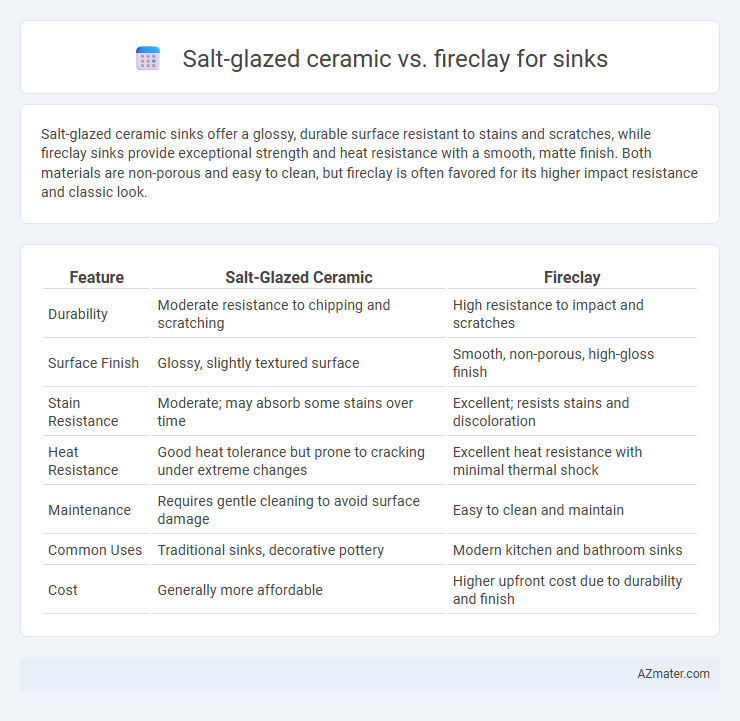Salt-glazed ceramic sinks offer a glossy, durable surface resistant to stains and scratches, while fireclay sinks provide exceptional strength and heat resistance with a smooth, matte finish. Both materials are non-porous and easy to clean, but fireclay is often favored for its higher impact resistance and classic look.
Table of Comparison
| Feature | Salt-Glazed Ceramic | Fireclay |
|---|---|---|
| Durability | Moderate resistance to chipping and scratching | High resistance to impact and scratches |
| Surface Finish | Glossy, slightly textured surface | Smooth, non-porous, high-gloss finish |
| Stain Resistance | Moderate; may absorb some stains over time | Excellent; resists stains and discoloration |
| Heat Resistance | Good heat tolerance but prone to cracking under extreme changes | Excellent heat resistance with minimal thermal shock |
| Maintenance | Requires gentle cleaning to avoid surface damage | Easy to clean and maintain |
| Common Uses | Traditional sinks, decorative pottery | Modern kitchen and bathroom sinks |
| Cost | Generally more affordable | Higher upfront cost due to durability and finish |
Introduction to Salt-Glazed Ceramic and Fireclay Sinks
Salt-glazed ceramic sinks are crafted by applying salt during high-temperature firing, creating a durable, glossy surface resistant to stains and scratches. Fireclay sinks consist of refined clay fired at extremely high temperatures, resulting in a dense, non-porous, and chip-resistant finish ideal for kitchen use. Both materials offer strong durability and aesthetic appeal, but Fireclay sinks generally provide superior impact resistance and a smoother glaze compared to traditional salt-glazed ceramics.
Material Composition and Manufacturing Process
Salt-glazed ceramic sinks are created by throwing salt into the kiln during firing, which reacts with the silica in the clay body to form a glassy, textured surface that enhances durability and resistance to stains. Fireclay sinks consist primarily of refined clay mixed with feldspar, forming a dense and non-porous material that withstands high temperatures and mechanical wear during firing at temperatures around 1300degC. The salt-glazing process imparts a unique glossy finish through vapor-phase reactions, while fireclay's manufacturing involves molding and high-temperature firing to achieve a smooth, chip-resistant surface ideal for heavy-duty kitchen use.
Durability and Longevity Comparison
Salt-glazed ceramic sinks offer high durability due to their dense, glass-like surface formed by salt vapor during firing, making them highly resistant to scratches and stains. Fireclay sinks, crafted from refined clay fired at extremely high temperatures, provide exceptional longevity with superior resistance to chips, cracks, and heat, often outlasting conventional ceramic options. Both materials are known for their robustness, but fireclay typically exhibits enhanced structural strength and longer-lasting performance in heavy-use kitchen environments.
Aesthetic Differences: Looks and Finishes
Salt-glazed ceramic sinks feature a distinctive textured surface with a glossy, slightly uneven finish created by the salt vapor firing process, offering a rustic and artisanal appearance. Fireclay sinks provide a smooth, glass-like surface with a highly durable, uniform glaze that delivers a sleek, polished look ideal for modern and traditional kitchens alike. The salt-glazed finish often displays subtle variations and a natural patina over time, while fireclay maintains a consistent, pristine aesthetic resistant to scratches and stains.
Resistance to Stains, Scratches, and Impacts
Salt-glazed ceramic sinks offer high resistance to stains due to their dense, vitrified surface, making them less porous and easier to clean compared to fireclay sinks. Fireclay sinks excel in impact resistance because their thick, tempered clay base withstands heavy knocks and rough handling without chipping. Both materials resist scratches well, but fireclay's tougher surface provides slightly better durability against abrasive wear in kitchen environments.
Maintenance and Cleaning Requirements
Salt-glazed ceramic sinks feature a glassy, non-porous surface that resists stains and simplifies cleaning, requiring only mild soap and water to maintain their shine. Fireclay sinks, known for their durability and smooth finish, demand gentle cleaning to prevent surface scratches and benefit from regular removal of mineral deposits to avoid dullness. Both materials offer low maintenance, but salt-glazed ceramics typically endure harsher cleaning agents better than fireclay, which can be sensitive to abrasive cleaners.
Cost Comparison: Price Range and Value
Salt-glazed ceramic sinks typically range from $150 to $400, offering a durable and cost-effective option with natural resistance to stains and scratches. Fireclay sinks, priced between $300 and $800, provide a higher-end, non-porous surface known for superior strength and long-lasting finish, which justifies the steeper investment. Evaluating cost against longevity and maintenance, fireclay sinks deliver better value for buyers seeking premium durability and aesthetic appeal.
Environmental Impact and Sustainability
Salt-glazed ceramic sinks utilize a natural salt firing process that reduces the need for harmful glazes and chemicals, making them an eco-friendly choice with a lower environmental footprint. Fireclay sinks are made from refined clay mixtures fired at high temperatures, producing a durable and non-porous surface but requiring significant energy for production. Both materials offer excellent longevity that minimizes replacement frequency, but salt-glazed ceramics generally have a more sustainable manufacturing process due to fewer chemical additives and lower emissions.
Installation Considerations and Compatibility
Salt-glazed ceramic sinks are heavier and require sturdy cabinetry and professional installation to support their weight and prevent damage. Fireclay sinks, made from refined clay fired at high temperatures, are also dense but offer increased impact resistance, allowing for easier handling during installation. Both materials are compatible with standard plumbing fixtures, but careful sealing and alignment are crucial to prevent leaks and ensure long-term durability.
Final Verdict: Which Sink Material is Best for You?
Salt-glazed ceramic sinks offer superior resistance to scratches and stains due to their vitrified surface, making them ideal for heavy use in busy kitchens, while fireclay sinks boast exceptional durability and classic aesthetics with a more traditional, handcrafted appeal. Fireclay's non-porous finish resists chips and discoloration, perfect for homeowners seeking a timeless look combined with sturdy performance. For those prioritizing long-lasting strength and ease of maintenance, fireclay generally holds an advantage, but salt-glazed ceramic suits modern, high-traffic environments with a sleek, contemporary style.

Infographic: Salt-glazed ceramic vs Fireclay for Sink
 azmater.com
azmater.com